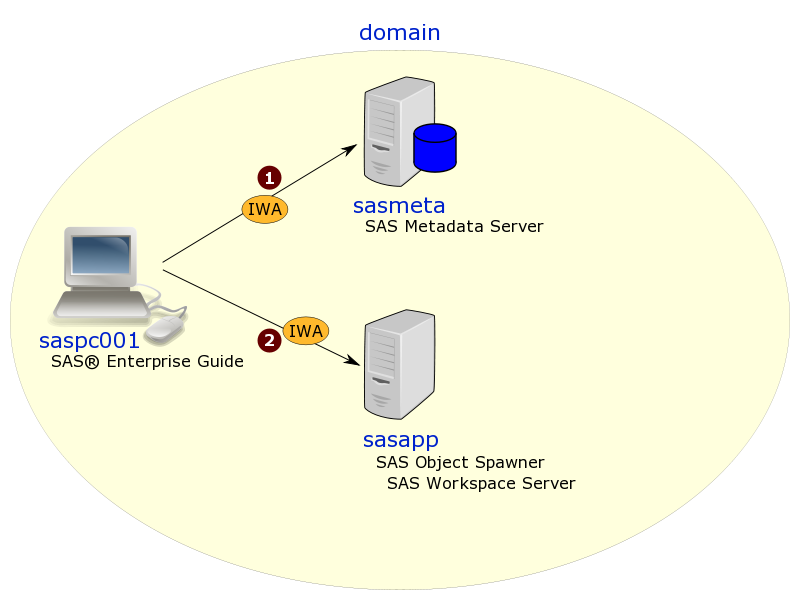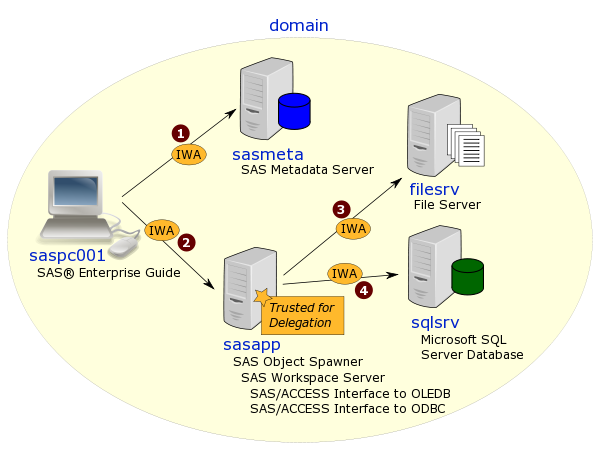Update 26Sep2018: This post is now a few years old and naturally technology and security have progressed in that time. For more up to date information regarding delegation and, in particular, the requirement for constrained delegation when working with Windows Defender Credential Guard in Windows 10 and Windows Server 2016, please see Stuart Rogers’ very useful SAS Global Forum 2018 Paper: SAS 9.4 on Microsoft Windows: Unleashing Kerberos on Apache Hadoop.
Continuing on the theme of configuring a SAS 9.4 M2 platform on Linux to use Integrated Windows Authentication (IWA), in this post I’m going to jot down some notes on steps 12-15 – configuring the SAS mid-tier on a Linux server for IWA with fallback to form-based authentication (when IWA is not available). This includes delegation, so that IWA users of mid-tier apps like SAS Studio are able to get IWA access to a SAS Workspace Server (and avoid having to store their passwords in metadata or switch to using SAS Token Authentication).
If you’re wondering what happened to steps 1-11, I’ll try get to those earlier steps in future posts. I’m starting at step 12 because someone recently asked me a question about configuring an IWA mid-tier and so it seemed like a good idea to get this blog post done first. Of course, when actual implementing, it’s always good to start at the beginning, building up the foundations, and verifying those first steps are working well before moving on to the next steps. So these steps assume you already have a working implementation where SAS desktop applications (like SAS Management Console & SAS Enterprise Guide) are able to connect to the SAS metadata server using IWA, and also to get IWA access to an appropriately configured SAS Workspace Server.
I have found the best mid-tier related documentation resources for this type of configuration are these ones:
- SAS Global Forum Paper SAS102-2014: An Advanced Fallback Authentication Framework for SAS® 9.4 and SAS® Visual Analytics by Zhiyong Li & Mike Roda (SAS Institute)
- The Support for Integrated Windows Authentication section in the SAS 9.4 Intelligence Platform: Middle-Tier Administration Guide, Second Edition
- The Web Authentication section in the SAS 9.4 Intelligence Platform: Middle-Tier Administration Guide, Second Edition
… and there are a few others listed in a previous blog post.
One of the reasons I’m writing this post is to get down some notes on a config that worked for me. The documents referenced above cover a variety of scenarios including plain basic web authentication with an XML file-based UserDatabaseRealm, an LDAP JNDIRealm, IWA (SPNEGO) without fallback, as well as fallback to form-based SAS authentication. Getting the right mix of settings, that didn’t conflict with each other, took me a long time to determine (my mid-tier takes about 20 minutes to restart whenever I want to test a modified config). Along the way I encountered pop-up basic web authentication dialogs when IWA should have worked, and infinite browser-refresh loops for the SAS Logon Manager when IWA was disabled in the browser and I was expecting fallback to SAS authentication. This post is about the final config that worked for me. I know I’ll be referring to this post again, and I hope it proves helpful to others too.
Here goes … Continue reading “Config Notes: SAS Mid-Tier (Linux) IWA with Fallback”


